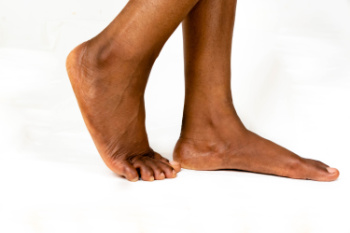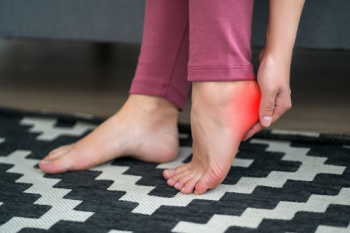Items filtered by date: February 2024
Definition of Flat Feet

Flat feet, or fallen arches, can lead to discomfort and pain, affecting daily activities. Treatment options aim to alleviate symptoms and improve foot function. Custom-made orthotics to support the arch and provide cushioning, can help distribute pressure evenly and reduce pain. Wearing supportive footwear with proper arch support and shock absorption can also alleviate discomfort. Stretching exercises to strengthen the muscles and improve flexibility may be beneficial. In severe cases, corticosteroid injections may be recommended to reduce pain and inflammation. Surgery is rarely necessary, but may be considered for individuals with persistent pain and significant foot deformities. If you have pain from having flat feet, it is suggested that you schedule an appointment with a podiatrist for an evaluation and a plan tailored to your individual needs.
Flatfoot is a condition many people suffer from. If you have flat feet, contact Franklin Harry, DPM from Best Foot Forward. Our doctor will treat your foot and ankle needs.
What Are Flat Feet?
Flatfoot is a condition in which the arch of the foot is depressed and the sole of the foot is almost completely in contact with the ground. About 20-30% of the population generally has flat feet because their arches never formed during growth.
Conditions & Problems:
Having flat feet makes it difficult to run or walk because of the stress placed on the ankles.
Alignment – The general alignment of your legs can be disrupted, because the ankles move inward which can cause major discomfort.
Knees – If you have complications with your knees, flat feet can be a contributor to arthritis in that area.
Symptoms
- Pain around the heel or arch area
- Trouble standing on the tip toe
- Swelling around the inside of the ankle
- Flat look to one or both feet
- Having your shoes feel uneven when worn
Treatment
If you are experiencing pain and stress on the foot you may weaken the posterior tibial tendon, which runs around the inside of the ankle.
If you have any questions please feel free to contact our offices located in Festus and St. Louis, MO . We offer the newest diagnostic and treatment technologies for all your foot and ankle needs.
Polydactyly Versus Syndactyly in Congenital Foot Conditions
 Polydactyly and syndactyly are different congenital foot conditions that affect the development of the toes. Polydactyly occurs when there are extra toes on the foot. This condition can vary in severity. Some people having a small extra toe that may not cause significant issues. Others may have a fully formed extra toe that requires surgical removal for functional and cosmetic reasons. Conversely, syndactyly occurs when two or more toes are fused together. This condition ranges from partial fusion, where only the skin connects the toes, to complete fusion, where the bones are fused together. Syndactyly can affect adjacent toes or more distant toes. Polydactyly and syndactyly are generally treated surgically to restore normal toe alignment and function. If you or your child has a congenital foot condition, it is suggested you consult with a podiatrist for proper evaluation and tailored management options.
Polydactyly and syndactyly are different congenital foot conditions that affect the development of the toes. Polydactyly occurs when there are extra toes on the foot. This condition can vary in severity. Some people having a small extra toe that may not cause significant issues. Others may have a fully formed extra toe that requires surgical removal for functional and cosmetic reasons. Conversely, syndactyly occurs when two or more toes are fused together. This condition ranges from partial fusion, where only the skin connects the toes, to complete fusion, where the bones are fused together. Syndactyly can affect adjacent toes or more distant toes. Polydactyly and syndactyly are generally treated surgically to restore normal toe alignment and function. If you or your child has a congenital foot condition, it is suggested you consult with a podiatrist for proper evaluation and tailored management options.
Congenital foot problems require immediate attention to avoid future complications. If you have any concerns, contact Franklin Harry, DPM of Best Foot Forward. Our doctor can provide the care you need to keep you pain-free and on your feet.
Congenital foot problems are deformities affecting the feet, toes, and/or ankles that children are born with. Some of these conditions have a genetic cause while others just happen. Some specific foot ailments that children may be born with include clubfeet, polydactyly/macrodactyly, and cleft foot. There are several other foot anomalies that can occur congenitally. What all of these conditions have in common is that a child may experience difficulty walking or performing everyday activities, as well as trouble finding footwear that fits their foot deformity. Some of these conditions are more serious than others. Consulting with a podiatrist as early as possible will help in properly diagnosing a child’s foot condition while getting the necessary treatment underway.
What are Causes of Congenital Foot Problem?
A congenital foot problem is one that happens to a child at birth. These conditions can be caused by a genetic predisposition, developmental or positional abnormalities during gestation, or with no known cause.
What are Symptoms of Congenital Foot Problems?
Symptoms vary by the congenital condition. Symptoms may consist of the following:
- Clubfoot, where tendons are shortened, bones are shaped differently, and the Achilles tendon is tight, causing the foot to point in and down. It is also possible for the soles of the feet to face each other.
- Polydactyly, which usually consists of a nubbin or small lump of tissue without a bone, a toe that is partially formed but has no joints, or an extra toe.
- Vertical talus, where the talus bone forms in the wrong position causing other bones in the foot to line up improperly, the front of the foot to point up, and the bottom of the foot to stiffen, with no arch, and to curve out.
- Tarsal coalition, when there is an abnormal connection of two or more bones in the foot leading to severe, rigid flatfoot.
- Cleft foot, where there are missing toes, a V-shaped cleft, and other anatomical differences.
- Macrodactyly, when the toes are abnormally large due to overgrowth of the underlying bone or soft tissue.
Treatment and Prevention
While there is nothing one can do to prevent congenital foot problems, raising awareness and receiving neonatal screenings are important. Early detection by taking your child to a podiatrist leads to the best outcome possible.
If you have any questions please feel free to contact our offices located in Festus and St. Louis, MO . We offer the newest diagnostic tools and technology to treat your foot and ankle needs.
Scar Management of Foot Wounds

Properly caring for foot or ankle surgical scars is closely linked to the different stages of wound healing. When preparing a patient for surgery, it is important to consider factors that cannot be changed, such as age and any history of raised scars. To prevent scars from getting worse, the most important thing to control is the tightness of the wound during healing. This depends on how the surgical cut is made. Usually, cuts are made along the natural lines of the skin, but in some areas, there are no such lines. Taking care of a surgical scar does not stop when the stitches are removed, and it should continue for about a year. Podiatrists will keep checking the scar during follow-up visits to make sure it is not getting worse. If it starts to become raised and thick, steroid injections and other treatments can be used to help. If you are having foot or ankle surgery, it is suggested that you speak to a podiatrist about past wound healing
Wound care is an important part in dealing with diabetes. If you have diabetes and a foot wound or would like more information about wound care for diabetics, consult with Franklin Harry, DPM from Best Foot Forward. Our doctor will assess your condition and provide you with quality foot and ankle treatment.
What Is Wound Care?
Wound care is the practice of taking proper care of a wound. This can range from the smallest to the largest of wounds. While everyone can benefit from proper wound care, it is much more important for diabetics. Diabetics often suffer from poor blood circulation which causes wounds to heal much slower than they would in a non-diabetic.
What Is the Importance of Wound Care?
While it may not seem apparent with small ulcers on the foot, for diabetics, any size ulcer can become infected. Diabetics often also suffer from neuropathy, or nerve loss. This means they might not even feel when they have an ulcer on their foot. If the wound becomes severely infected, amputation may be necessary. Therefore, it is of the upmost importance to properly care for any and all foot wounds.
How to Care for Wounds
The best way to care for foot wounds is to prevent them. For diabetics, this means daily inspections of the feet for any signs of abnormalities or ulcers. It is also recommended to see a podiatrist several times a year for a foot inspection. If you do have an ulcer, run the wound under water to clear dirt from the wound; then apply antibiotic ointment to the wound and cover with a bandage. Bandages should be changed daily and keeping pressure off the wound is smart. It is advised to see a podiatrist, who can keep an eye on it.
If you have any questions, please feel free to contact our offices located in Festus and St. Louis, MO . We offer the newest diagnostic and treatment technologies for all your foot care needs.
Relationship of Heel Spurs to Plantar Fasciitis

Plantar heel pain is a widespread problem that affects many people from different backgrounds. It can make life difficult for those who are affected by it. A common issue is plantar fasciitis. Some studies have linked heel spurs to plantar fasciitis. People with type 2 spurs, or posterior calcaneal spurs, seem to have more pain before and after surgery, and their foot function is not as good as those with other types of spurs. Type 2 heel spurs are categorized based on their location and are typically found on the back of the heel, just above the insertion point of the Achilles tendon. They are more likely to cause plantar fasciitis. Type 2 heel spurs are differentiated from type 1 heel spurs, also known as inferior calcaneal spurs. They are found on the undersurface of the heel bone, and type 3 heel spurs, or superior calcaneal spurs, which are found on the upper surface of the heel bone. If you have a heel spur that is causing you pain, it is suggested that you schedule an appointment with a podiatrist to understand what type of heel spur you have and how your pain might be relieved.
Heel spurs can be incredibly painful and sometimes may make you unable to participate in physical activities. To get medical care for your heel spurs, contact Franklin Harry, DPM from Best Foot Forward. Our doctor will do everything possible to treat your condition.
Heels Spurs
Heel spurs are formed by calcium deposits on the back of the foot where the heel is. This can also be caused by small fragments of bone breaking off one section of the foot, attaching onto the back of the foot. Heel spurs can also be bone growth on the back of the foot and may grow in the direction of the arch of the foot.
Older individuals usually suffer from heel spurs and pain sometimes intensifies with age. One of the main condition's spurs are related to is plantar fasciitis.
Pain
The pain associated with spurs is often because of weight placed on the feet. When someone is walking, their entire weight is concentrated on the feet. Bone spurs then have the tendency to affect other bones and tissues around the foot. As the pain continues, the feet will become tender and sensitive over time.
Treatments
There are many ways to treat heel spurs. If one is suffering from heel spurs in conjunction with pain, there are several methods for healing. Medication, surgery, and herbal care are some options.
If you have any questions feel free to contact our offices located in Festus and St. Louis, MO . We offer the latest in diagnostic and treatment technology to meet your needs.

